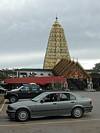|
Wat Wang Wiwekaram (วัดวังก์วิเวการาม)
Thai. ‘Wang
[Ka]
temple of the desolate
araam’. Name of a temple situated on a hill side near the banks
of
the Khao Laem reservoir
in
Sangkhlaburi,
where it was relocated from the local valley when it was submerged
to create the lake. Some of the old temple buildings now at the
bottom of the reservoir, can still be seen when the water level is
low, whereas the
ho rakhang,
i.e. the belfry, which is topped by several Thai national flags and
Thai Buddhist flags
(fig.),
is exposed permanently due to its taller size. It is rumoured that
the monks still row over in a small boat every day (fig.)
to ring the still functional bell (fig.). The current hilltop temple
complex is built in a mixture
of Thai, Burmese and Hindu styles and the
monastery's abbot is a highly respected
Luang Pho.
The temple's
viharn
is a spacious building (fig.)
which houses a
Buddha image
in the
maravijaya
position, the most
common
mudra in Thai Buddhist art.
This example
is a copy of an image from
Chaiya
in
Srivijaya
style
(fig.).
In the northern area of the main complex is a large wooden hall where
phra kruh
monks a run a school for local
Mon
kids (fig.). It has a strange combination, in that the
Buddha
is
sitting
on
the snake
Muchalinda
whilst performing this
mudra (fig.),
and is understood to represent a summary of the entire story of his Enlightenment,
since the position of this mudra refers chronologically to a scene just
prior to
Siddhartha's
Enlightenment,
whereas the
protection by Muchalinda happens much later, after the Buddha's Enlightenment, almost
at the end of his life story.
The temple's
main
pagoda
is erected in the style of the
Maha Bodhi pagoda in
Bodhgaya
(India) and is one of several such pagodas in Thailand, others
include those of
Wat Yahn
in
Chonburi
(fig.)
and
Wat Mahathat Wachiramongkon
in
Krabi
(fig.). The pagoda
is located some distance away and downhill from the main complex, on
the northwestern bank of the Khao Laem reservoir, and is a local landmark
that is noticeable from afar and doubles as a beacon for any boat
traveling on the lake (fig.).
It
is built on a raised platform
which can be reached by a spiral
staircase. Halfway up this
staircase
is a large
wooden
dhammachakka,
i.e. the Buddhist ‘Wheel
of Law’ (fig.)
that symbolizes the ongoing cycle of cause and effect in ones life,
with 24 spokes, representing the hours in a day. From the surrounding balcony a closer look at the pagoda
reveals its many corners, projections, dents and
niches,
many of which are adorned with
Buddha images in different poses.
Visitors come here and try to throw small coins into an elevated
niche that holds a white stone Buddha image, an endeavor that is
believed to bring the pitcher good luck if successful, and since one attempt
might not suffice many are seen scrambling the floor in search for
their coin that has bounced back from the wall (fig.).
At the base of the pagoda, underneath the platform, there is a large
hall (fig.) with around the central support for the pagoda eight
cylindrical altars that are set up
akin
to the Burmese system of an animal-per-day (fig.)
which is similar to the Thai
sat prajam wan-system
(fig.),
and
each altar is topped with some
Buddha images. Locally, the temple is also called Wat
Mon.
See also POSTAGE STAMP,
TRAVEL PICTURES (1) and (2),
as well as
MAP (1)
and
MAP (2).
回






|

